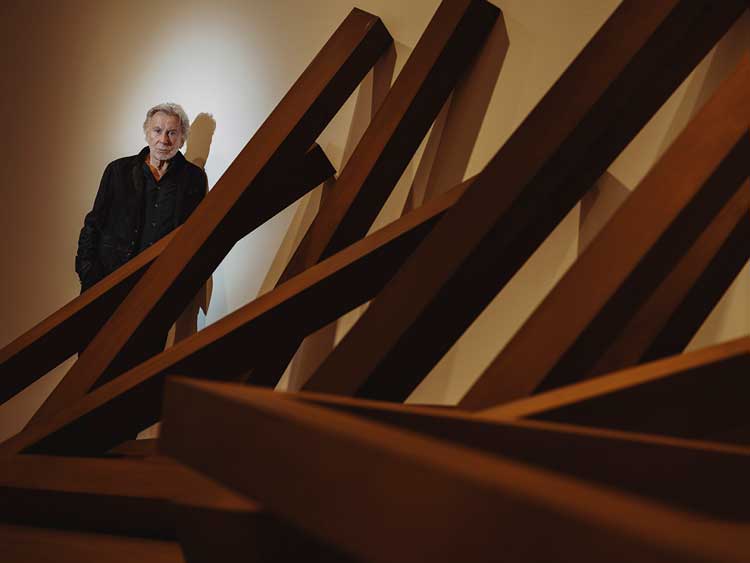
Bernar Venet. Photo: Benjamin McMahon.
by VERONICA SIMPSON
Bernar Venet (b1941, Château-Arnoux, France) is every inch the genial host. Widely cited as ‘France’s greatest living sculptor’ (by Christie’s and the New York Times, to name just two), he is still as tall and energetic at 81 as he looks in edgy New York studio photos of the 1970s, when he was a pioneering figure on that city’s conceptual art scene. On a warm summer’s day in 2022, he is clad head to toe in white linen, as he welcomes a small UK delegation to his home and studio at Le Muy in Provence. Originally an old factory, which he converted in the 1970s, it is set beside an old mill with a river roaring past it. The kinetic energy of this rushing water suits the restless spirit of this endlessly inventive artist.
Venet still spends time in New York, but is now resident in Le Muy, overseeing the evolution of his Venet Foundation. Established in 2014, along with the buildings he has renovated and expanded for storage, display and living, it now has an impressive sculpture park, with some outstanding examples of work by his contemporaries (Donald Judd, James Turrell and Sol LeWitt among them) in one section. Across a small, country road, further rolling green acres are dedicated to his own long-limbed, Corten steel constructions, inspired – as is almost everything he does – by mathematics. With enormous presence and grace, they arc, coil and drape across the lawns. He tells us he has bought up most of the land and buildings around the mill and factory.
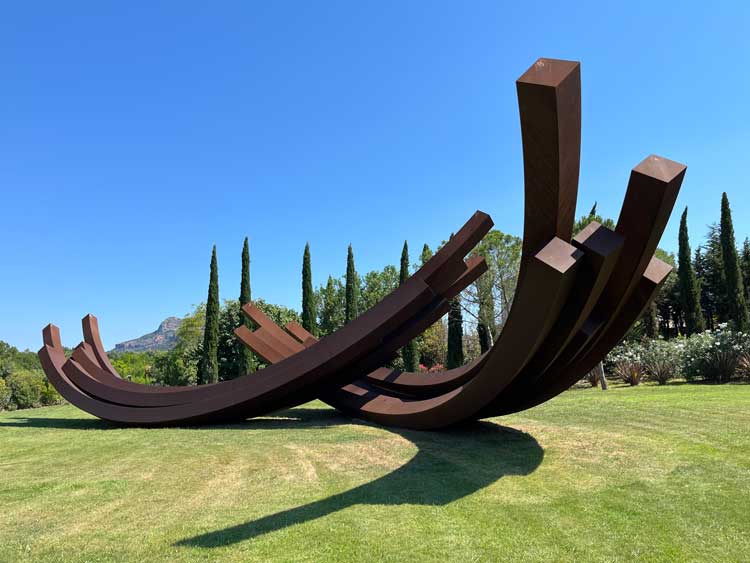
Venet Foundation sculpture park, Le Muy, Provence. Photo: Veronica Simpson.
Our small party of two writers, two film-makers and a gallerist is ushered to an outdoor table laid for a light but nourishing lunch, accompanied by the local rosé. We are well placed to admire his sculptures, his collection, the elegant trees he has accommodated and added to, his futuristic living space within the factory, not to mention a small swimming pool, as we are entertained effortlessly by Venet and his wife, Diane. The phrase “living the dream” springs to mind – and Venet would be the first to admit his good fortune.
He talks often and without regret of his impoverished upbringing; indeed, that absence of comfort, of indulgence seems to have powered his inventiveness as well as resourcefulness. Even as a soldier in Algeria during his national service, he managed to co-opt a shed in which to create his groundbreaking Déchet series, in which he dripped industrial paint on to cardboard (simply using the available materials). The inventiveness continued after his military service, seeing him create Tas de Charbon (Pile of Coal, 1963), his first sculpture with no defined shape, just certain prescribed dimensions, while a penniless artist working alongside others in Nice.
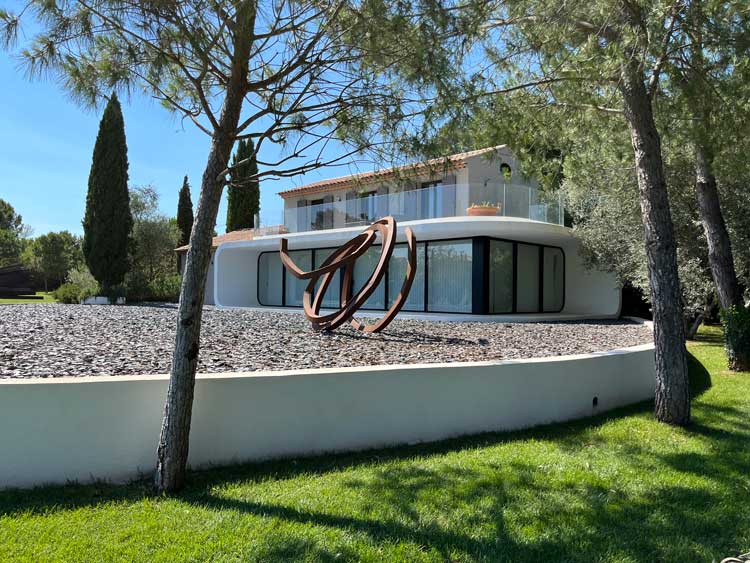
Bernar Venet sculpture outside a recently expanded living space at Le Muy. Photo: Veronica Simpson.
Three years later he moved to New York, where he was soon hanging out with Judd, Frank Stella, Jasper Johns, Mark Rothko and Andy Warhol, among others, and participating in group shows at the top galleries. Then, as now, “the idea was to create work which wasn’t like anything before it, and which didn’t mean anything beyond the artwork itself. It wasn’t figurative and it wasn’t abstract,” he told Christie’s magazine in 2017. His work encompassed sound, film, poetry and literature; he even choregraphed and scored a ballet. Marcel Duchamp, the father of conceptual art, apparently met him in New York shortly before his death, and compared his work – admiringly, one assumes - to “la vente de vent” (the sale of wind). His fortunes improved. In 1994, Jacques Chirac, then mayor of Paris, asked him to place 12 of his Indeterminate Lines (the aforementioned Corten steel geometric sculptures) on the Champ de Mars: this kicked off a world tour and supercharged Venet’s global profile. He was made a Chevalier de la Légion d’Honneur (France’s highest honour) in 2005, and, in 2007, the French ministry of culture commissioned him to paint the ceiling of the Galerie Philippe Séguin in Paris. He was a strong presence at the 2009 Venice Biennale (with his work The Arc Hypothesis). In 2011, he became only the fourth contemporary artist to be offered the grounds of the Château de Versailles for a solo exhibition. Over the last two decades, demand for his sculptures has grown; they crop up in public spaces everywhere, from the grassy square in front of the Kode Art Museum in Bergen to a Belgian motorway. His work is in the collections of 70 museums worldwide.
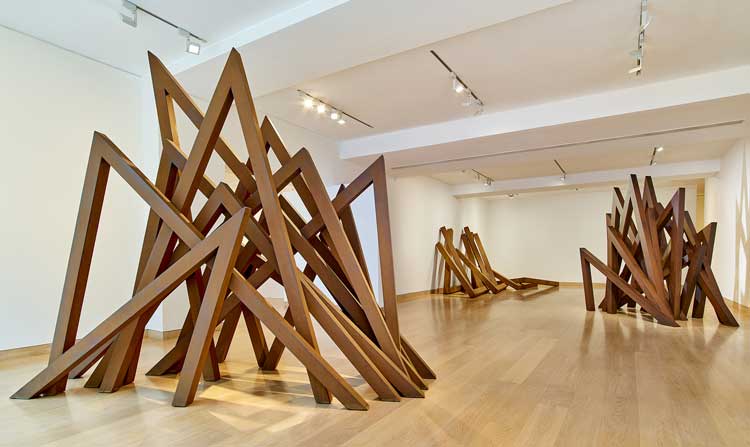
Installation view, Bernar Venet: Hypotheses at Waddington Custot, September 2022. Photo: Pru Cumings Associates. Courtesy Waddington Custot.
For some reason, he is less well known in the UK. Before 2017, his last solo London show had been in 1976 at the ICA; the three outings of his work in 2017 comprised a retrospective at Blain Southern, a presence in the Frieze Sculpture programme and 10 new works arranged around the Cliveden estate in Buckinghamshire. He currently has a new solo show at Waddington Custot, dedicated to his Angles as a way of exploring further his beloved mathematics.
Veronica Simpson: You have just had your biggest and most comprehensive retrospective to date in Berlin (at Kunsthalle Berlin, Tempelhof Airport) and another huge show in China, with two more coming up in London. Is it still good to be so busy?
Bernar Venet: I remember the days when I was going to visit Christo, and I had nothing to do at the time, and he said: “Bernar, Bernar, sit down, look at some book. Take it easy. I have so much work.” And then one day he came to my place, and I said: “Christo, can you wait 30 minutes more because I have to finish something.” It was crazy.
VS: There seems to be a real appetite for sculpture now, and on a gargantuan scale. What do you think is driving that?
BV: There are rich people who buy beautiful houses, they have land, they are involved with art, just the same way that they are buying paintings. And it’s true that Sotheby’s and Christie’s are doing a good job, making sure that sculpture is promoted. And in Florida, I can tell you, they did something fantastic for me. For 2007, Sotheby’s were planning an exhibition near Orlando, at Isleworth Country Club, of sculpture from Picasso, Jean Arp, Max Ernst, Joan Miró and all the way to Richard Serra and Louise Bourgeois, nothing more recent. They called me and said: “Would you have two or three pieces for us? We’d like to include you in that big exhibition?” I said: “With Pleasure.” It was a good environment for me to be in, so I sent them two pieces, big ones, and the show opened on 3 January 2007.
They sent me a message on 9 January. They said: “Bernar, we have sold your two pieces, do you have more?” I didn’t because I had a big show in Bordeaux, so it was not very convenient, but I said I was going to be in New York in one month, so I met Stephane Connery, the stepson of Sean Connery, who was the director of private sales at Sotheby’s. He said let’s have lunch together. We sit down. He says: “Happy surprise, there was so much interest, but we wanted to have more pieces. Bernar, we have a proposition: would you accept to have a one man show next year, 2008?” I said give me one day. I had to talk to my wife, to my assistant. They said come on, you have to do it. Sotheby’s made 6,000 catalogues that they sent out to the best collectors, the most important collectors, so I did it. That was a very important moment for me. That one and Versailles, I think they were determinant.
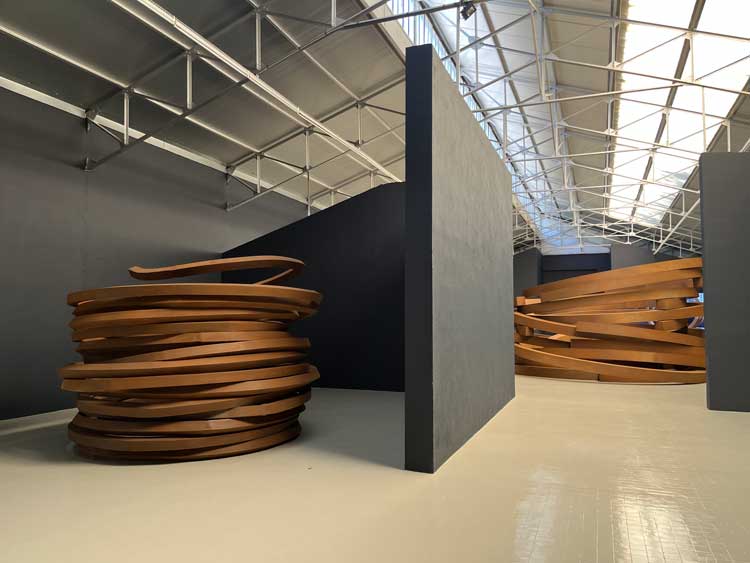
Sculptures by Bernar Venet inside his Factory gallery at Le Muy. Photo: Veronica Simpson.
VS: It is fascinating to see your work in this space, along with the other works you have collected. You get a real sense of the context of your work and how your practice has been empowered through these huge display spaces, as well as the relationship of the works to the landscape. Also, through your own experience as a curator, curating your own work and that of your friends, the dialogue seems to be continuous.
BV: Yes, it has to move. This year I slowed down a little bit because I decided I was going to buy some artworks from other artists. In a year and a half, I bought seven to eight pieces. It was a good year; I could do it. My dealers could help me a little. The artists were helping. I got very good prices. You have to be connected and know the artists, and sometimes the collectors, who want to acquire some works of mine. I can be a little bit difficult sometimes because you cannot just distribute your work like this. It’s not merchandise – you have to know where it’s going. I don’t have a big sense of strategy. But I just know that I cannot give to everybody who wants a sculpture of mine in their garden. Sometimes, I say no to some dealers. Then one day they will call me and say they have the Frank Stella I saw last time. They say: “Why don’t you give us a piece like this, and we’ll give you a Frank Stella.” This has happened with one Frank Stella, and with some Richard Long. Really there is a soul in this collection. Most of those people are my friends. There is only Tony Smith whom I never met. It’s a generation. It shows a context. This is the context in which I was functioning. And they are very strong personalities. They are not just friends because they are friends. They have to be very radical, historical. I’m not just decorating my garden.
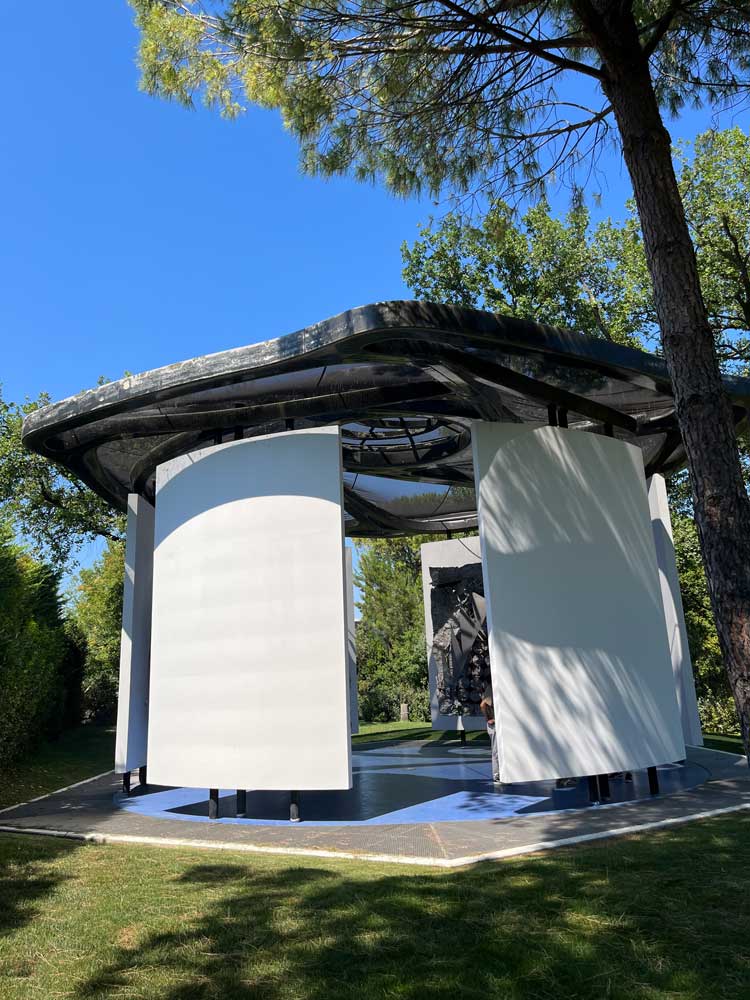
Frank Stella, Chapel, at the Venet Foundation, Le Muy. Photo: Veronica Simpson.
VS: But it is also great to see them here in the current context where there is a renewed appetite for that spirit of the 60s and 70s, for that time of experimentation and collaboration, with no interest in the market. That was such fertile ground in which so many ideas flourished.
BV: It was definitely another era. Today, the market is too important. I would like to acquire one or two pieces. I would like to have a Richard Serra here, and Ellsworth Kelly. You have to be a millionaire to buy these. Richard would be easier – I talk to him, I know him well, but he’s so complicated. One day I was in his studio and I said: “Richard, tell me, if you were to make an exchange with some artist of your generation, who would you like to have?” He said nobody. I said: “Surely, someone like Louise Bourgeois, Donald Judd?” He said no, he wasn’t interested. I said: “OK, fine. But two weeks ago, I was at Donald Judd’s building, I saw a piece on the floor and [he] told me that it was yours and that you made an exchange.” Richard said: “Yes, I gave him my piece, but I don’t want his.” He’s a fantastic artist, but he has such an ego, so I don’t even want to ask him anything – though it would be great to have a piece here.
But I’m giving everything away. This is never going to be sold. Have I told you the story of the Venet Foundation? When I came here it was a factory. I was not thinking of starting a foundation, but slowly I improve, improve, improve, and then I have my own work here and then, some years later, the National Gallery of Berlin wants to come and visit me, and that day I look around me and I say, it’s too nice. The day I die I don’t want my kids to sell this. I talk to them, and I say what about making a foundation. People will be able to come, and nothing is going to be sold and we have all the art there, and they say, of course, no problem. You did it. I said to them that, when I started, I was so poor. My family were extremely poor and today look what I have.
But what I have today is thanks to a context of society around me, of people who helped me, who pushed me, I owe it to that society. We have to give back everything to society. And this is what we are doing. Nothing belongs to me here. I don’t care to own anyway.
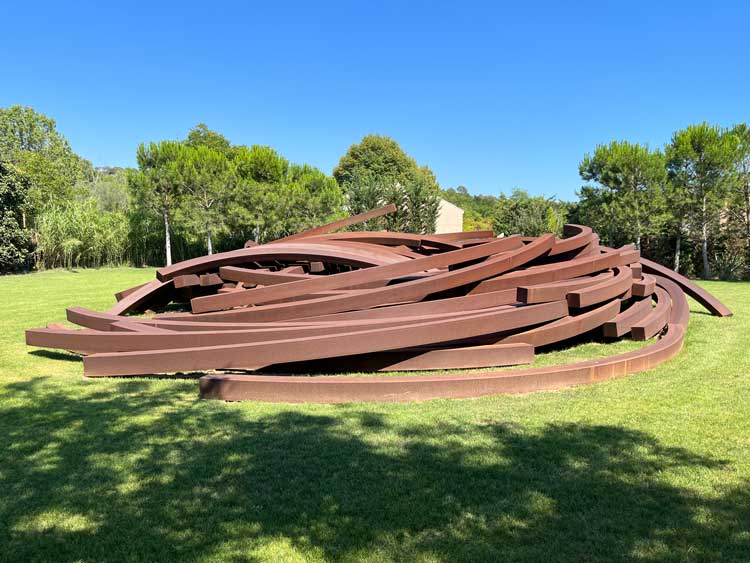
A collapsing sculpture by Bernar Venet in the grounds at Le Muy, Provence. Photo: Veronica Simpson.
VS: But the spirit you demonstrate here is also very personal – your collection, your curation, your way of living and working. This comes across strongly.
BV: It’s nice to show the context, the historical context. People come here and they learn something. They like the beauty of the garden and everything, but the art and so on, it’s a complete thing. And we have many schools who are coming here, art schools also, so we are trying to communicate that context.
VS: That is a very optimistic thing to do, and it must have shaped your approach to how other people curate space, how others curate your work.
BV: The lesson was coming from Donald Judd. He was a very good friend. In fact, he was showing me slides of when he was doing Marfa (his living and studio sculpture space in Texas). He was building the building and doing all these things, saying come and spend a week there, and because of my work, I was not doing it. The day I went there – unfortunately, it was after he died – I realised it was complete engagement. It’s the only way to present your work the right way. And that factory, for me here, that’s a fantastic thing, and I change the configuration every year. It allows me to do things that are exceptional in scale and artistically ambitious in my context.
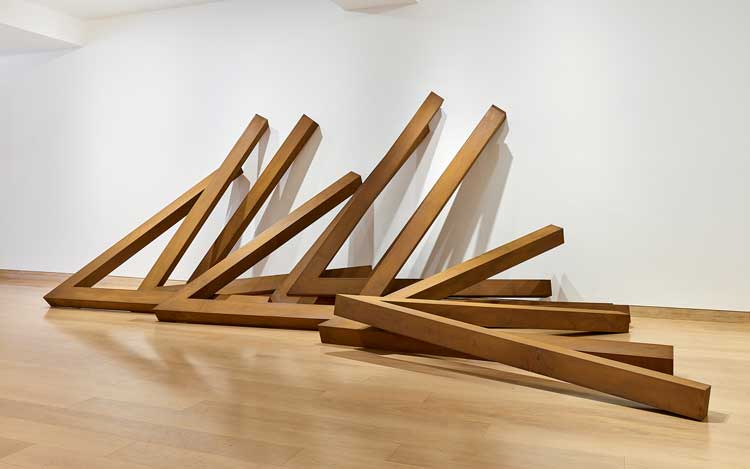
Installation view, Bernar Venet: Hypotheses at Waddington Custot, September 2022. Photo: Pru Cumings Associates. Courtesy Waddington Custot.
VS: You were saying you have a foundry in Hungary that is more or less dedicated to producing your work, so now you are a producer as well. What does that give you as an artist and how has your practice responded to that extra capacity and freedom? They are so good, you said, that they have become like “your hands”.
BV: It just feels fantastic because you can do what you want. You just have to think, to have your brain thinking about great things. That’s all. Then there is no limit. Fortunately, we sell enough to do what we want. But those people are so dedicated, and they are so proud to do things that are not just gates and windows, they do artworks that are going all around the world. I sell them in South Korea, I send them to Denver, Colorado, to England, everywhere. They are so happy with that. It is a fantastic privilege to have found those people, really. With the French, it was terrible. They did not take me seriously. I was asking them to make a piece for a show, giving them a maquette, the proportions, and it was never ready. In Hungary, everything can be just on time, they do it right.
VS: How many people are in your team, here and there?
BV: There are 22 people working for me there, and 13 to 14 here.
VS: We were discussing over lunch how public art has had such a difficult time in some parts of the world – such as the UK, where it is less respected or valued – but here in France, and also in the US, they have long been ahead of the curve.
BV: I think the French were so good when Jack Lang arrived [he was the minister of culture from 1981 to 1986 and again from 1988 to 1993], with [President François] Mitterrand. It was in 1993, they contacted artists and asked them to make very big sculptures. This is how I started to work on my Arc Majeur, a piece on [a Belgian] highway. Unfortunately, we never realised it in France, because the administration is such a drag, but you see the willingness to do things was already there. You can see that at La Defense where they placed the huge [Alexander] Calder, the Miró, and many things. And there I also made a sculpture very early on in 1997. The French were pretty good at doing that. The Americans, they are also good, and they have those sculpture parks. America was looking for monumental things. Immediately they saw I was doing big things, they jumped on me. I did six pieces in three years.
VS: In America, that is led by private philanthropy, but it is to France’s credit that it is the public sector that has such a bold approach to public art and sculpture.
BV: Yes, I never thought about it like that, but, yes, we have so many books now on public sculpture, financed by the ministry of culture. Sometimes people say to me [that my] dream is just to make big sculpture. My dream is not to make big sculpture, my dream is to make sculptures that are new, radical, different, things that have never been considered before.
And if I prefer to make a piece big, like this, you look at that and say this is the beginning of something. The day that my pieces fall like this by accident, and I think, “Wow this is what I’m going to work on, these collapsed pieces”, these are the real moments of creation. I make them big, and it works, but it’s a new experience for sure. It’s not easy to make a big piece, you know. It has to work. Many things are big, but they are not always very satisfying, they are just bigger and that’s all. With my work, fortunately, the fact that it’s abstract and that I have the good sense of proportions helps. You don’t just multiply everything … you have to work it out.
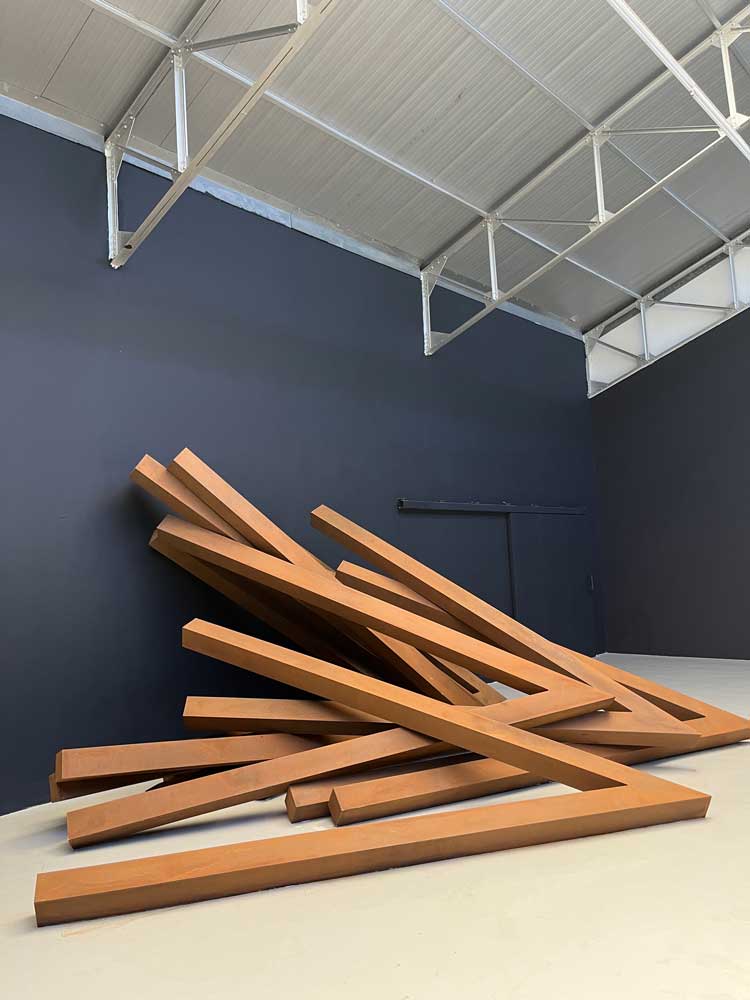
Collapsing sculpture by Bernar Venet inside his Factory gallery at Le Muy. Photo: Veronica Simpson.
VS: There are also rich associations with the work – especially the collapsed sculptures. We are so aware of human civilisation being at a point of collapse, and that seems to resonate with these works.
BV: I don’t think about that. It’s not an illustration of what the world is. No, it’s just for me a way to make a new configuration that I have not considered before. All my work has been very auto-referential. You know, when I was doing the charcoal pile, I was calling that a charcoal pile. This is exactly what you have in front of you. The tar paintings were the tar paintings. There is a title, but the title says what it is. There is a huge difference between “Untitled” and that. Then my mathematical paintings, they were very much about monosemy - artworks that have only one level of signification. Everything has always been like this. Gravity, nature, have always been a concern for me.
VS: Are there any other artists you admire currently?
BV: I think, no. An artist I admire more than anybody is Frank Stella because of his constant creativity, but he can make paintings and sculptures but it’s one or the other. No, I don’t see anybody, I think … nobody who is going into music and literature and poetry and video. But, with me, it’s really in my nature.
VS: Where does this lack of a sense of boundaries come from, your sense of freedom?
BV: There is so much to create, why would I stop? Yes, people can find a way to make a concept that people recognise, then make 500, 600 or 800 more, then sell them and make money. When you do that, it’s a job. No, I’m an artist. I’m constantly obsessed with one thing now: what can I do that will change everything again? I don’t care about what I’ve done. My only obsession today is what can I do that will be interesting.
• Bernar Venet: Hypotheses is at Waddington Custot, London, until 12 November 2022.